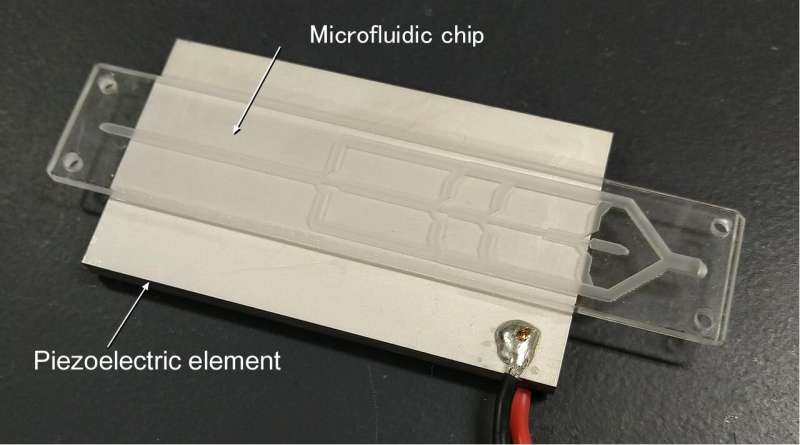This article has been reviewed according to Science X's editorial process and policies. Editors have highlighted the following attributes while ensuring the content's credibility:
fact-checked
proofread
Filtering pollution: A microfluidic device for collecting microplastics via acoustic focusing

Plastic debris particles smaller than 5 mm in size, known as microplastics (MPs), are a serious environmental concern. Formed by the breaking down of plastic waste due to wear and tear and sunlight or produced by fiber waste in laundry wastewater and as microbeads in beauty products, they adsorb and introduce harmful chemicals that pollute the environment. By 2050, MPs might outnumber the fish in the oceans. Under these circumstances, the collection and removal of MPs from water are crucial.
Conventionally, MPs are collected by filtering water through meshes. The sand and biological debris are removed from the collected MPs by density separation and chemical treatment, respectively. After that, the MPs are manually picked up, which is laborious and time-consuming. In addition, the meshes can easily get clogged and cannot collect particles smaller than their aperture. They also require frequent maintenance and are expensive. Given these shortcomings, researchers have developed microfluidic devices—systems that control small amounts of fluids using micrometer-sized channels—that utilize acoustic focusing to collect MPs.
The acoustic technology generates ultrasonic waves that transport MPs to the center of the fluid stream and thereby enrich, i.e., increase the collected amount, of MPs. However, high enrichment of MPs using current microfluidic devices requires repeated recirculation of fluids through them. In this light, a group of researchers, led by Professor Yoshitake Akiyama of the Department of Mechanical Engineering and Robotics at the Faculty of Textile Science and Technology at Shinshu University, has developed a high enrichment device for 10–200 μm MPs.
This device has been reported in a study co-authored by Professor Hiroshi Moriwaki of the Department of Applied Biology, Faculty of Textile Science and Technology, Shinshu University, which was made available online on March 26, 2023 and will be published in the Separation and Purification Technology journal on June 15, 2023.
"Our proposed microfluidic device, which is designed based on a hydraulic–electric analogy, has three 1.5 mm-wide microchannels connected via four serial 0.7 mm-wide trifurcated junctions. The MPs are aligned at the center of the middle microchannel using a bulk acoustic wave of 500 kHz resonance frequency. As a result, a 3.2-fold enrichment of MPs must occur at each junction, resulting in a 105-fold overall enrichment in the device," explains Prof. Akiyama, describing the design of their device. While the MPs are collected from the middle branch of the trifurcated junctions, the remaining MP-free fluid is removed from the other branches.
The researchers evaluated the collection performance of the device by measuring its total collection rates for microparticles 5, 10, 15, 25, 50, and 200 μm in diameter. The collection rates exceeded 90% for all but 5 μm microparticles, which were too small to control acoustically. Furthermore, the researchers tested the device using two sample water mixtures, one with small MPs (25–200 μm) and another with very small MPs (10–25 μm). Its collection rates ranged from 70%–90%, and the actual enrichment of MPs varied from half the design value of 105 to the design value.
Although some MPs were found to slow down and clog the microchannel walls of the device by acoustic radiation force, the researchers believe these minor limitations can be easily addressed through pre-filtration and by improving 2D focusing.
Prof. Akiyama thus concludes, "This proposed microfluidic device based on acoustic focusing can efficiently, rapidly, and continuously collect 10–200 μm MPs without recirculation after pre-filtration of larger MPs through a mesh. It can be installed in washing machines, factories, and other sources of MPs for efficiently enriching and removing various-sized MPs from laundry and industrial wastewater. This will make it possible to prevent the discharge of MPs to the environment."
More information: Tatsuki Jonai et al, A collection device for various-sized microparticles that uses four serial acoustic separations: Working toward microplastic emission prevention, Separation and Purification Technology (2023). DOI: 10.1016/j.seppur.2023.123697

















